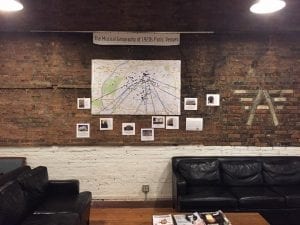Yesterday, we held the opening of our exhibit at the Alliance Française in Minneapolis. It will run for two weeks, and then we get to keep pretty, glossy pictures, so really it’s awesome. A lot of people came to enjoy the remarks, exhibit, and refreshments provided, and it really showed that our research matters to people we don’t even know.

A general view of the exhibit. The venue already had books, the French flag, a piano, and other decor that indicated a desire to unite Minneapolis with French culture in some way. Really, this was the ideal venue and it added a lot to our exhibit.
We had a main information table and four other tables, each for our individual projects (Jazz, Second Viennese School, Bolero, and Ballets Russes). Basically, at each table we included a general overview, books on the subject, and glossy pictures of old programs, letters, sketches, portraits, scores, venues, and our maps. We also incorporated QR codes to link to the maps so people could interact with them on their phones. We also had a large venues map blown up and on the wall with our exhibit title and pictures of what we believe to be the most important/influential venues in Paris at the time. In addition to all of this, we had a slideshow of 1920s archival videos with people like Josephine Baker dancing, and we had a Spotify playlist of music from different genres of the time playing as well. Basically, we were walking into 1920s Paris without realizing it.
My individual table on the Ballets Russes incorporated books (ex: Diaghilev’s Ballets Russes by Lynn Garafola), pictures of Leon Bakst’s sketches for the costumes of Narcisse and Firebird, some costumed dancers from Le sacre du printemps by Stravinsky, the Théâtre des Champs-Élysées, a program from one of their performances, and a pic and bio of Sergei Diaghilev.
I didn’t realize how much work we actually would need to do – figuring out how to format documents to print HUGE maps and titles along with pictures that needed their public domain status double-checked; finding and contacting someone able to print said items (thank you, St. Olaf IT and Digital Scholarship Center staff and interns); creating handouts for the exhibit and posters for the tables, figuring out publicity and advertising, and then going up to set everything up. What a whirlwind of events!
I also found that it really helps you realize that you can take on responsibility confidently. With so many tasks to complete, there wasn’t always time to double check with everyone that they approved of your formatting of everything or to see if everyone could help you do something. You really have to take it upon yourself to do the best you can and follow every guideline you can find to make it right the first time. Hopefully, your team members can weigh in on things, but if there just isn’t enough time, you have to be responsible and accountable for the materials that you bring to the table, and I think that was a valuable lesson to learn.
Overall, I think that this valuable learning experience was an excellent way to showcase all of the hard work that we have done so far this summer, and I’m grateful that we had such a wonderful opportunity like this.

You must be logged in to post a comment.